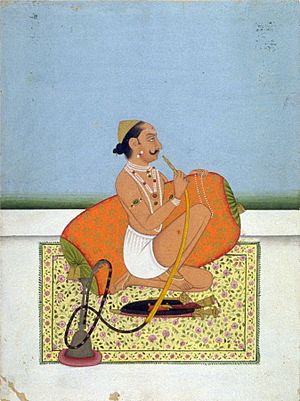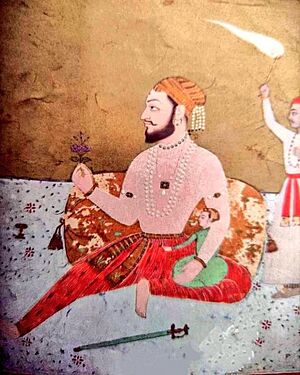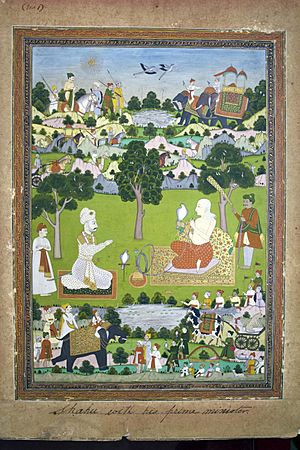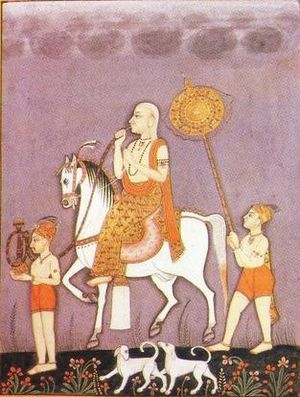Shahu I facts for kids
Quick facts for kids Shahu I |
|
|---|---|
| Chhatrapati of the Maratha Empire | |

Early 19th-century depiction of Shahu I.
|
|
| Reign | 12 January 1707 –15 December 1749 |
| Coronation | 12 January 1708, Satara |
| Predecessor | Shivaji II |
| Successor | Ramaraja II |
| Peshwa |
|
| Born | Shahu Sambhaji Raje Bhosale 18 May 1682 Mangad Fort, Maratha Empire (modern-day Mangaon, Maharashtra, India) |
| Died | 15 December 1749 (aged 67) Rangmahal Palace, Satara, Maratha Confederacy (modern-day Maharashtra, India) |
| Spouse |
|
| Issue |
|
| House | Bhosale |
| Father | Sambhaji I |
| Mother | Yesubai |
| Religion | Hinduism |
| Signature |  |
Shahu I (born Shahu Sambhaji Raje Bhosale, 1682–1749) was an important leader of the Maratha Empire. He was the fifth Chhatrapati, a title like a king, of the empire. His grandfather, Shivaji Maharaj, founded this empire. Shahu was the son of Chhatrapati Sambhaji Maharaj.
When he was very young, Shahu was captured by the Mughal Empire ruler Aurangzeb. He was held captive until Aurangzeb died. After his release, Shahu fought a civil war against his aunt, Tarabai, to claim the throne. He won the Battle of Khed and became the Chhatrapati.
During Shahu Maharaj's rule, the Maratha Empire grew much stronger. Its power and influence spread across a large part of India. After his death, his top ministers and generals continued to manage different parts of the empire.
Contents
Early Life and Capture

Shahu was only seven years old when he was captured. This happened in 1689 after the Battle of Raigarh (1689). He and his mother were taken prisoner by the Mughals.
The Mughal emperor Aurangzeb hoped to use Shahu. He wanted to control the Marathas through their young heir. So, he treated Shahu and his mother well. Even while captive, Shahu's mother, Queen Yesubai, managed her own lands.
Shahu married two daughters of important Maratha leaders. These leaders served the Mughals. Aurangzeb even gave Shahu valuable swords. He also granted him rights to lands and income. This was for Shahu's upkeep.
After Aurangzeb died in 1707, one of his sons, Prince Azam Shah, freed Shahu. Azam Shah hoped this would cause fights among the Marathas. He also wanted Shahu's help in his own fight for the Mughal throne.
At this time, Shahu's aunt, Tarabai, was ruling the Maratha kingdom. She ruled for her son, Shivaji. Tarabai said Shahu was not the real son of Sambhaji. She claimed the Mughals had replaced him. This led to a civil war between Shahu and Tarabai. Shahu fought to become the Chhatrapati in 1708 and won.
Becoming Chhatrapati
After Aurangzeb's death, Shahu wanted to return home. He was advised not to wait for official permission from Azam Shah. So, he left the Mughal camp on May 8, 1707.
Princes from different Indian states welcomed Shahu. They showed him great hospitality on his journey. Shahu visited the holy city of Ujjain. He paid his respects at the Shri Mahakaleshwar temple.
At Burhanpur, Shahu left someone behind. This person was to get official documents from the Mughals. Shahu then met Rawal Mohansinh, a local ruler. Mohansinh had rebelled against Aurangzeb. He was the first to support Shahu. He helped Shahu with soldiers and money.
More Maratha chiefs joined Shahu as he traveled. These included important families like the Bokils and Purandares.
Early Conflicts
When Shahu reached Maharashtra, many leaders joined him. Senasahibsubha Parsoji Bhonsle, with 15,000 troops, pledged his loyalty. Other important leaders quickly followed.
Tarabai's forces gathered for a fight. On August 3, 1707, Shahu received official recognition from Bahadur Shah. Bahadur Shah had defeated Azam Khan. The Mughal Emperors recognized Shahu as the rightful heir. They also agreed to pay the Marathas a tax called Chauth. This was a quarter of their revenue. They also paid an extra 10% for protection.
Battle of Khed
Shahu faced some resistance on his way to Khed. He captured a small fortress at Parad. He adopted a boy named Fatesinh from there. Shahu saw this as his first victory.
Before the main battle, Shahu secretly met Dhanaji Jadhav. Dhanaji was a powerful Maratha general. Shahu convinced Dhanaji to support him.
The Battle of Khed happened on October 12, 1707. Shahu personally led his soldiers. Tarabai's forces suffered heavy losses. Dhanaji Jadhav only pretended to fight. This was because he had already promised to support Shahu.
Shahu won a great victory. After the battle, he captured several forts quickly. Within a month, he reached Satara Fort. He demanded the fort surrender. When it didn't, he began a siege.
Shahu learned that the fort's commander, Sheikh Mira, had family in a nearby village. Shahu threatened to harm Sheikh Mira's family. This made Sheikh Mira open the fort gates to Shahu on January 1, 1708. Even Dhanaji Jadhav was surprised. Aurangzeb's huge army had taken nine months to capture Satara. Shahu took it in just eight days. Satara then became Shahu's capital.
Working with the Peshwas
During the civil war, Kanhoji Angre became very powerful. He was a naval admiral. He captured important trading centers and forts. Shahu sent his Prime Minister, Bahiroji Pingale, to stop him. But Kanhoji defeated Pingale and captured him.
Shahu then sent Balaji Vishwanath. Balaji was known for his negotiation skills. He met Kanhoji and convinced him to join Shahu. Kanhoji agreed to become the grand admiral of Shahu's navy. He would control the Konkan coast.
Balaji and Kanhoji then worked together. They attacked the Muslim Siddis of Janjira. Their combined forces captured most of the Konkan coast. Shahu was very pleased with Balaji's success. He made Balaji Vishwanath his new Peshwa (Prime Minister) on November 16, 1713.
Ending the Civil War
Udaji Chavan, a Maratha lord, caused trouble in Shahu's lands. He was allied with Tarabai's son, Sambhaji. Udaji often raided Shahu's territories. Shahu invited Udaji for a meeting. Udaji tried to have Shahu assassinated. But the assassins were so impressed by Shahu that they gave up. They told Shahu about Udaji's plan.
Shahu then decided to fight Sambhaji. Shambhusimha Jadhav and Pratinidhi attacked Sambhaji's camp. They defeated most of Kolhapur's army. Sambhaji's mother and wife were taken prisoner. Shahu treated them kindly. Tarabai decided to live with Shahu in Satara, ending her role in the civil war.
Shahu's forces captured Vishalgad. This forced Sambhaji to agree to a peace treaty. The two cousins met at Jakhinwadi plain. It was a grand event with many soldiers and nobles. Sambhaji showed his respect to Shahu. Shahu embraced him. They exchanged gifts, ending the ceremony.
Two months later, the "Treaty of Warana" was signed. This officially ended the Maratha Civil War. Kolhapur became a part of Shahu's empire.
Expanding the Empire

Over the next fifty years, Shahu's Peshwas expanded the empire. Balaji Vishwanath's son, Bajirao I, and grandson, Balaji Bajirao, were key figures. They worked with skilled military leaders. These included the Shinde, Holkar, and Pawar clans.
The Marathas won important battles. The Battle of Palkhed in 1728 was a major victory against the Nizam of Hyderabad. After the Battle of Bundelkhand, the Marathas became very powerful in northern India.
During Shahu's lifetime, the Marathas conquered many regions. These included Bundelkhand, Malwa, and Gujarat. They also gained control of Gwalior and Kota.
Shahu's Character and Rule
Shahu cared deeply for his people, especially farmers. He helped bring barren lands under cultivation. He encouraged planting trees. He also removed unfair taxes to help the poor.
People called Shahu "Bhola Shankar," meaning a kind form of Shiva. He was known for being fair and just. He mixed freely with ordinary people. During festivals and celebrations, Shahu actively participated. He enjoyed seeing his people happy. People felt comfortable inviting him to their family events. He would join them and offer help if needed.
Writers of his time called him "Punyashloke," meaning someone with a good legacy. He was praised for choosing good officers. He gave them authority but also corrected their mistakes.
Shahu dressed simply, even in public. He had long gray hair. He was always easy to approach for anyone. He traveled around his empire with a small group. His secretary and clerks were always with him.
His daily routine was very organized. The poorest people could easily see him. They received quick and fair justice. He never ignored anyone who asked for help. On his tours, he would stop his palanquin or horse to listen.
Shahu enjoyed hunting every morning. This was his only exercise and recreation. After breakfast, he would work in his office. He carefully handled every matter. He patiently listened to every request. In the evening, a full court was held. Music and dancing often ended the day. It is said that Chhatrapati Shahu made decisions on at least 500 matters every day.
Family and Legacy
Shahu had four wives. They had two sons and four daughters. His queens, Sakwarbai and Sagunabai, had their own homes. They also had ministers to manage their affairs. They earned income from their lands and trade. They traded goods like fish, salt, and spices. The queens were aware of events on the Western Indian coast. They stayed in touch with important Maratha leaders.
Shahu adopted a girl named Parvati Kolhatkar when she was three. He trained her in warfare and administration. He later arranged her marriage to Sadashivrao Bhau.
He also adopted two sons. One was Ranoji Lokhande, renamed Fatehsinh I. The other was Rajaram II of Satara. Rajaram II later became his successor. Rajaram II was brought to Shahu by his aunt, Tarabai. She first claimed he was her grandson. Later, she said he was an imposter. But she finally admitted he was legitimate.
After Shahu's death, there were political struggles. His wives passed away due to these intrigues. His adopted son, Rajaram II, became the next Chhatrapati. However, the real power was held by others. First, Tarabai, and then Peshwa Balaji Baji Rao, held the power.
Shahu's capital city was named Shahunagar. He moved his throne to the Rangmahal Palace in 1721. He made sure the new city had good drinking water. He also established a mint there.
Shahu loved sports like hunting and fishing. He enjoyed music, bards, and actors. He had well-trained dogs and horses. He also liked rare items like candles, scents, and swords. He enjoyed beautiful gardens and imported rare fruit and flower trees.
Chhatrapati Shahu died on December 15, 1749. Many people mourned his death. A court historian described him as a "father and protector" to everyone. He said Shahu was a king like no other. Even criminals were treated fairly.
People told many stories about Shahu's generosity. He was often compared to Karna, a hero from the Indian epic Mahabharata.
Muzaffar Jang, a Mughal leader, praised Shahu after his death. He said Shahu was one of the greatest leaders. He managed his state well and had no enemies. He expanded the Maratha lands. Shahu found great joy in making others happy. He lived a simple life himself. He was truly a saint in this way. Even when faced with assassins, he let them go. This earned him great respect.
Images for kids
| Preceded by Shivaji II |
Chhatrapati of the Maratha Empire 1707–1749 |
Succeeded by Rajaram II of Satara |











